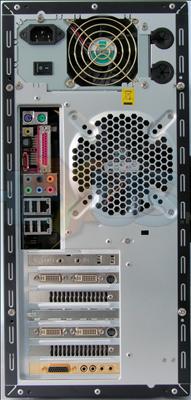System specification and initial look
The new ultimate PC? You decide...
| System name | MESH Elite Extreme SLI |
| Case | New Aluminium ATX Midi Tower(Wave) + Musketeer Display |
| Processor | Intel Core 2 Duo Extreme X6800 (2.933GHz, 4MiB L2 cache, LGA775) |
| Motherboard | ASUS P5N32-SLI Deluxe PCI-Express (nForce4 x16 SLI) |
| Memory | 2GBytes (2x 1GByte) OCZ PC6400 RAM @ 4-4-4-15 2T @ DDR2-800 |
| Hard drive(s) | Maxtor 6H500S0 500GB SATA, 16MB cache |
| Screen | 20.1in ViewSonic VP2030B (1600x1200) DVI |
| Graphics card | 2x NVIDIA GeForce 7900 GTX 512MiB in SLI |
| Optical drive #1 | Sony DW-G120A 16x DVD ReWriter |
| Optical drive #2 | Sony CRX320EE 16x DVD-ROM |
| Sound | Creative SoundBlster X-Fi Fatal1tyFPS |
| Speakers | Creative T7900 |
| Modem | None |
| Networking | Gigabit Ethernet from nForce4 SLI chipset. Marvell PCIe Gbe | Ports connectivity | 10x USB2.0 (2x top, 4x rear I/O), 1x FireWire400, 2x RJ45 (Gigabit), audio, optical/coaxial S/PDIF-out, PS/2, eSATA, parallel |
| Operating system | Windows XP MCE 2005 |
| Additional software | Microsoft Works 8.5. CyberLink video-editing suite - 7 titles |
| PSU | HEC 550W |
| Warranty | 3 years onsite (Premiere warranty) |
| Price | £2,499 including VAT |
| Shipping | £39 + VAT (£45.83 inc. VAT) |
| Other notables | Logitech cordless keyboard and mouse |
The first surprise is in specifying the Intel-oriented nForce 4 SLI-based ASUS P5N32-SLI Deluxe motherboard. MESH is proving that Core 2-based desktop processors are compatible with NVIDIA's last-generation chipset. Perhaps it was too early to specify an nForce 590 SLI Intel Edition?. Of course, Core 2 CPUs do have different power requirements to their predecessors, so the motherboard itself must also be up to date with respect to meeting those requirements. In this case, the P5N32-SLI is reckoned to be just fine and game for some Core 2 action.

The entire system looks sleek in black. Black may well be the new beige, but at least it looks good. Nothing in the system looks out of place, MESH having wisely chosen to keep everything one colour.

MESH's chassis keeps a clean face thanks to a front panel door that's high quality in both appearance and feel. Opening this door reveals the populated expansion bays. At the top is the Musketeer display, with analogue meters for rear fan voltage, system temperature and audio volume; we like a bit of retro. Next we have two optical drives, the topmost a Sony DVD writer and the one below a Sony DVD-ROM. Filling the last 5.25" bay is the control panel for the Sound Blaster X-Fi Fata1ityFPS. The good old floppy disk drive's still hanging around, too.
Despite being hidden away by a door most of the time, MESH has still ensured that the expansion bay components match the system in colour.

What we'd normally refer to as 'front' connectivity ports are, in fact, on the top of this case. The now fairly standard contingent of FireWire, line-out, microphone and two USB ports are present.

Internally, the MESH Elite Extreme SLI is reasonably tidy, although we've seen better. Nevertheless, there doesn't appear to be any huge impedences to airflow through the case. Unfortunatley the X-Fi requires a ribbon cable between itself and its control console, and routing ribbon cables is no easy feat. The CPU area is nice and clear, and the motherboard allows for some breathing room between the two NVIDIA GeForce 7900 GTX 512MiB cards. There's no room for any extra PCI cards with the 7900s and X-Fi installed, however.
The Intel reference cooler is a little noisy, but with Q-Fan enabled in the system BIOS fan-speed regulation is decent. This wasn't on by default (neither was Execute Disable, the nx-bit feature on modern CPUs), so we hope MESH will ensure that these features are activated in shipping systems. The case has provision for two side fans, but none were present. Use of these, we feel, could keep the passive chipset cooling at a lower temperature and also help keep the speed of the CPU fan down.

Closer inspection revealed that the system's hard drive had a loose SATA cable. Such a problem could cause confusion for somebody receiving this system, or it might not be an issue until some point further down the line. However, until all SATA drives support ClickConnect-style cables, it is a little too easy for this to happen, so we can't really blame MESH on this account.
There are no extra SATA power connectors, so if a user were to add extra drives, power adapters would likely need to be purchased too. The front bezel is quite flimsy, unlike the door, so lifting of the case shouldn't involve grabbing this, if it can be helped.

The rear of the system is dominated by the 120mm fan. The motherboard's connectivity options are visible (which would normally feature an I/O plate, but its absence from our test system is no cause for concern), including eSATA, and both coaxial and optical digital audio connections. The 7900 GTX graphics cards take up most of the expansion slot space, with the X-Fi sitting at the bottom. Just next to the HEC PSU are two holes with grommits, revealing that this case could be used with an external watercooling system quite easily.
The base unit is well-presented and shows both the thought and care involved in its specification and design. Its clean look leaves the power under the hood somewhat understated... nothing's better than a bit of subtlety.









